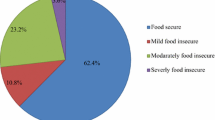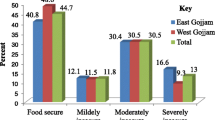Abstract
Seasonal food insecurity in Bangladesh is a multidimensional socioeconomic issue emanated from more than just access and availability of food. In general, it has been considered that the northern areas of Bangladesh, treated as monga-prone, is more vulnerable to seasonal food insecurity as compared to any other region of the country. The manifestation of monga is essentially food insecurity and consequent vulnerabilities. The paper investigates the seasonal food insecurity status, coping strategies along with its possible determinants linked to socioeconomic conditions of the affected households in Kurigram, one of the monga-prone districts of northern Bangladesh. A primary survey was conducted to explore the food insecurity status and diverse factors leading to food insecurity in terms of food consumption, livelihood and consequent family experiences in mitigating the severity of food insecurity during the monga (lean) period. The nature of household food insecurity seems to be an outcome of a variety of risk factors, as well as inability to manage those risks due to income and resource constraints. Moreover, a reduction in food intake during the monga period is one of the common scenarios in the study area. Marginal effects and elasticities after probit regression reveal that household’s income, share of per capita medical expenditure, safety net(s) involvement and the area of residence appear to be the leading factors affecting seasonal food insecurity during the monga period to a significant extent. Households with more medical expenditure (68 %), cultivable landholding (9 %) and households residing by the riverside (4 %) have a higher probability of food insecurity than their counterparts. On the contrary, relatively large size family (-16 %), higher income (-4 %) and safety net coverage (-19 %) have reduced the probability of food insecurity during the monga period. Finally, the paper concludes with some policy issues based on on-site observation and econometric analysis to overcome this transitory food insecurity in the monga-prone areas.
Similar content being viewed by others
References
Armah FA, Odoi JO, Yengoh GT, Obiri S, Yawson DO, Afrifa EAK (2011) Food security and climate change in drought-sensitive savanna zones of Ghana. Mitig Adapt Strateg Glob Change 16:291–306
BBS (2005) Statistical Yearbook of Bangladesh 2005. Bangladesh Bureau of Statistics, Dhaka
Braun J (2009) Addressing the food crisis: governance, market functioning, and investment in public goods. Food Sec 1:9–15
CARE (2005) Report on “Monga” in northern Bangladesh. Dhaka. Retrieved from http://www.lcgbangladesh.org/derweb/achieve/docs/2005/CARE%20Report%20on%20Monga%20%28Nov%202005%29.pdf. Accessed October 01, 2010
CARE, WFP (2008) The coping strategy index: field method manual. Cooperative for Assistance and Relief Everywhere (CARE) and World Food Programme (WFP)
Chaudhuri S, Jalan J, Suryahadi A (2002) Assessing household vulnerability to poverty: a methodology and estimates for Indonesia. Discussion paper no. 0102-52, Department of Economics, Columbia University, USA
Coates J, Wilde PE, Webb P, Rogers BL, Houser RF (2006) Comparison of a qualitative and a quantitative approach to developing a household food insecurity scale for Bangladesh. J Nutr 136:1420S–1430S
Deb UK, Islam AKMN, Khaled N, Nabi A, Al Amin M, Ahamad MG, Tasnima K, Paul DNR (2010) Vulnerability to climate change: adaptation strategies & layers of resilience in Bangladesh. Paper presented at international workshop on “Building Climate Resilient Agriculture in Asia” organized by International Crops Research Institute for the Semi-Arid Tropics (ICRISAT) and Centre for Policy Dialogue (CPD), Dhaka: 5-6 July 2010
Devereux S (2002) Can social safety nets reduce chronic poverty? Dev Pol Rev 20:657–675
FAO (1991) Sustainable agriculture and development in Asia and the Pacific. Regional document No. 2 FAO/Netherlands based on the conference on “Agriculture and Environment”, S-Hertogenbosch, The Netherlands 15-19 April 1991
FAO (1996) Rome declaration on world food security, world food summit. Food and Agriculture Organization (FAO), Rome
FAO (2003) International workshop on food security in complex emergencies: building policy frameworks to address longer-term programming challenges, Tivoli. 23-25 September 2003
Fullbrook D (2010) Food as security. Food Sec 2:5–20
Glomm G, Palumbo MG (1993) Optimal intertemporal consumption decisions under the threat of starvation. J Dev Econ 42:271–291
Khandker SR (2012) Seasonality of income and poverty in Bangladesh. J Dev Econ 97:244–256
Khandker SR, Khaleque A, Samad H. (2011) Can social safety nets cure Monga in North West Bangladesh? Working paper no. 10, Institute of Microfinance, Bangladesh
Khondker RK (2010) Food poverty and consequent vulnerability of children: a comparative study of ethnic minorities and monga-affected households in Bangladesh. Final report PR #7/08, NFPCSP, Bangladesh
Mallick D, Rafi M (2010) Are female-headed households more food insecure? Evidence from Bangladesh. World Dev 38(4):593–605
Mazumder MSU, Wencong L (2012) Monga vulnerability in the northern part of Bangladesh. Afr J Agr Res 7(3):358–366
Musyoka MP, Lagat JK, Ouma DE, Wambua T, Gamba P (2010) Structure and properties of urban household food demand in Nairobi, Kenya: implications for urban food security. Food Sec 2:179–193
Pinstrup-Andersen P (2009) Food security: definition and measurement. Food Sec 1:5–7
Rahman HZ (2005) Monga forecast 2005: field assessment and action plan. Power and Participation Research Centre (PPRC), Dhaka
Rawlani AK, Sovacool BK (2011) Building responsiveness to climate change through community based adaptation in Bangladesh. Mitig Adapt Strateg Glob Change 16:845–863
Sen B (2009) Risks, Vulnerability and poverty in Bangladesh: issues and evidence. Conference paper. Retrieved from http://depot.gdnet.org/gdnshare/pdf/paper%20SEN.doc Accessed June 3, 2010
Shahabuddin Q, Ali Z (2006) Natural disasters, risks, vulnerability and persistence of poverty: an analysis of household level data. PRCPB working paper no. 15, Bangladesh Institute of Development Studies (BIDS), Dhaka, Bangladesh
VAM (2009) Bangladesh poverty map. Bangladesh Bureau of Statistics, Vulnerability Assessment and Mapping (VAM) unit. World Food Programme (WFP) and World Bank, Dhaka, Bangladesh
WFP (2005) Bangladesh food security brief. Vulnerability Analysis and Mapping (VAM) unit, Dhaka, Bangladesh
Whiting EF, Ward C (2010) Food provisioning strategies, food insecurity, and stress in an economically vulnerable community: the Northern Cheyenne case. Agric Hum Values 27:489–504
Zug S (2006a) Monga - seasonal food insecurity in Bangladesh-bringing the information together. The Journal of Social Studies, No. 111, Jul-Sep 2006, Centre for Social Studies (CSS), Dhaka
Zug S (2006b) Monga-seasonal food insecurity in Bangladesh. NETZ, Dhaka. Retrieved from http://www.bangladesch.org/pics/download/Final_Report_Monga_Sebastian_Zug.pdf. Accessed June 27, 2010
Acknowledgements
The authors are appreciative for comments received from two anonymous reviewers and Robert K. Dixon, Editor-in-Chief of “Mitigation and Adaptation Strategies for Global Change” that certainly have improved the quality of the paper. The authors are also grateful to Mr. Shah Alam and Mr. Md. Sumon Reza for their enormous efforts during data collection period. The views expressed in this paper are those of the authors and do not necessarily reflect the views of any institutions with which the authors are affiliated.
Author information
Authors and Affiliations
Corresponding author
Rights and permissions
About this article
Cite this article
Ahamad, M.G., Khondker, R.K., Ahmed, Z.U. et al. Seasonal food insecurity in Bangladesh: evidences from northern areas. Mitig Adapt Strateg Glob Change 18, 1077–1088 (2013). https://doi.org/10.1007/s11027-012-9408-0
Received:
Accepted:
Published:
Issue Date:
DOI: https://doi.org/10.1007/s11027-012-9408-0




